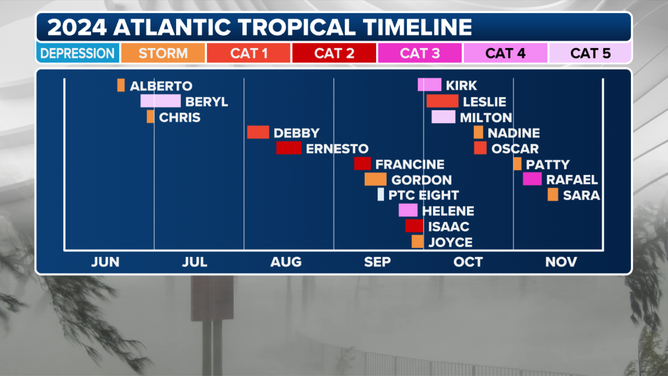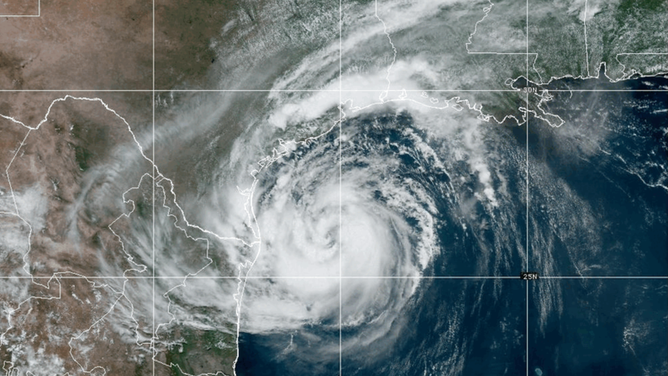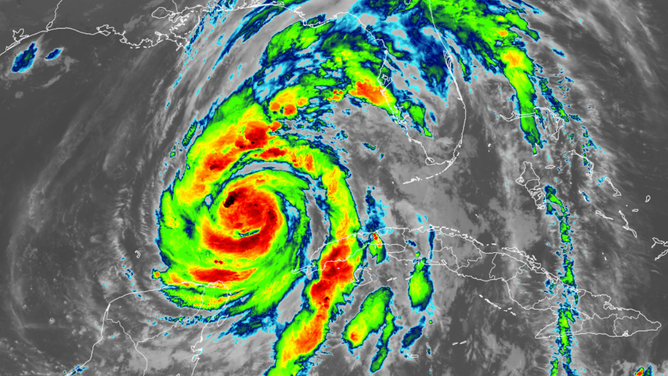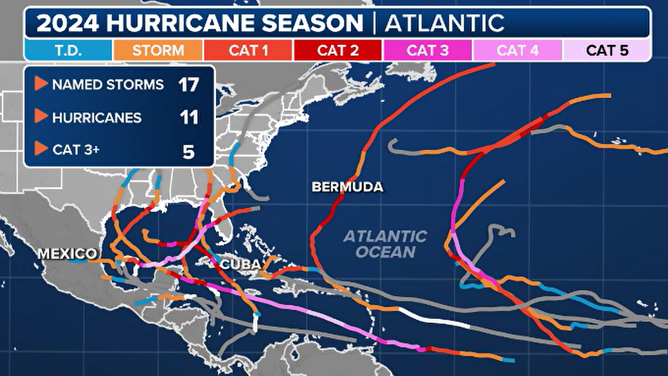2024 Atlantic hurricane season drawing to a close as among costliest on record
Initial damage estimates put losses at around $200 billion, making 2024 the second-costliest season on record, despite the season falling short of preseason expectations.
Report: 2024 hurricane season could become one of the costliest on record
We’re in the final month of the Atlantic hurricane season, but preliminary economic loss data indicates that 2024 is likely to become one of the more costliest hurricane seasons of the modern era. Jeff Waters of Moody’s joined FOX Weather over the weekend to break down the numbers.
The 2024 Atlantic hurricane season was marked by an unusual pattern of storm development, but despite the damage, season activity was below what forecasters believed would occur.
Between June 1 and the end of November, 18 named storms formed across the basin, with 11 becoming hurricanes and five strengthening into major cyclones. Eight hurricanes made landfall; five of which struck the U.S.
The numbers were above the averages of 14 named storms, 7 hurricanes and 3 major storms that form during a typical season.
2004: A HURRICANE SEASON THAT FLORIDA NEVER WANTS TO REPEAT
The first named storm, Tropical Storm Alberto, didn’t form until June 19 — marking the slowest start to the hurricane season in a decade. However, a period from mid-September through October helped to make up for the shortfall.
During the peak of the season, 10 named storms formed, three of which made landfall along the U.S. Gulf Coast as hurricanes.
Initial damage estimates put losses at around $200 billion, making 2024 the second-costliest season on record, despite the season falling short of preseason expectations.

Hurricane season 2024 summary
(FOX Weather)
Forecasters miss mark on season activity
While the number of cyclones might seem impressive, forecasters were expecting a busier year.
Colorado State University initially forecast a season with 23 named storms, 11 hurricanes, and 5 major hurricanes, but revised those figures upward in their July update.
At the time, forecasters cited record warm water temperatures and the evolving La Niña as factors that should lead to an active season. However, the El Niño-Southern Oscillation never transitioned to La Niña during the hurricane season.
But the quieter-than-expected conditions were not limited to the Atlantic—they were observed across every ocean in the Northern Hemisphere, leading many to question whether climate change could be behind the decrease in cyclone activity.
Tropical systems in the Atlantic basin produced the most Accumulated Cyclone Energy (ACE) compared to normal, while oceans such as the Indian and Pacific saw significant inactivity.
The Atlantic basin reported ACE values more than 34% above the typical yearly average, while the Indian Ocean was down more than 67% and the Pacific Ocean was off by at least 37%.
Most of the Atlantic’s ACE was due to hurricanes such as Beryl, Kirk and Milton, which accumulated the most points.
HELENE KILLS 11 MEMBERS OF THE SAME FAMILY AFTER MUDSLIDE
Hurricanes Beryl, Helene, and Milton Set Records
Hurricane Beryl, which formed at the end of June, made history as the earliest Category 5 hurricane on record and became only the second recorded Category 5 hurricane to form in July.
The cyclone was relatively small, which allowed it to avoid hostile conditions and quickly develop east of the Lesser Antilles.
It impacted several islands and Mexico before weakening and making landfall along the Texas coastline, south of Houston.
At least 3 million power outages were reported from the hurricane, and more than 40 deaths were attributed to the cyclone in the U.S.

Tropical Storm Beryl on Sunday afternoon as seen by NOAA's GOES-EAST satellite.
Hurricane Helene formed in the western Caribbean before making landfall along Florida’s Big Bend on Sept. 26.
Helene also became a major hurricane before landfall, but the storm will be remembered for its catastrophic flooding in the Carolinas.
Rainfall totals topped 30 inches in North Carolina, compounded by days of heavy rain ahead of the hurricane.
Many communities in and around Asheville were either underwater or completely cut off from first responders.
The cyclone was not only the costliest but also the deadliest of the season, with more than 230 lives lost.

Hurricane Helene Satellite Image Sept. 26, 2024.
(FOX Weather)
Following Alberto, Beryl, Chris, Debby, Francine and Helene, Milton became the strongest cyclone of the year in the Gulf of Mexico.
Milton reached Category 5 status on Oct. 7, with maximum sustained winds of 180 mph and a pressure of 897 millibars.
Fortunately for Florida’s west coast, the hurricane weakened into a Category 3 before making landfall near Sarasota on Oct. 9.
Following the hurricane, a data analysis company estimated damages would top $30 billion.
Milton was also the last hurricane to impact the Lower 48, bringing an end to an active landfall season in the U.S.
2023 HURRICANE SEASON: LEAST IMPACTFUL FOR U.S. IN NEARLY A DECADE

Hurricane season 2024 summary
(FOX Weather)
Plenty of work during the off-season
Although the Atlantic basin is outside the official hurricane season from December through May, forecasters at the National Hurricane Center will still have plenty of work to do.
Staff will complete storm summaries for the 18 cyclones that formed in 2024, review messaging that could be improved, and prepare for the World Meteorological Organization’s annual hurricane meeting, scheduled for March.
At the 47th Session of the RA IV Hurricane Committee, countries will share best forecasting practices, examine potential changes for future seasons, and request the retirement of cyclone names associated with significant loss of life and destruction.
In addition to meetings and preparations for the 2025 season, forecasters will also be closely monitoring the Atlantic basin for off-season development.
Since record-keeping began in the 1850s, there have been at least 71 storm formations each month outside of the official hurricane season.
May tends to be the busiest off-season month, with 42 cyclones forming, followed by December and April.
Forecasters caution that the formation of a cyclone before the official start of a hurricane season does not offer any clues about how active the upcoming season will be.
The next hurricane season will begin on June 1, 2025, and run through November 30, 2025.

2025 Hurricane Season Names
(FOX Weather)
